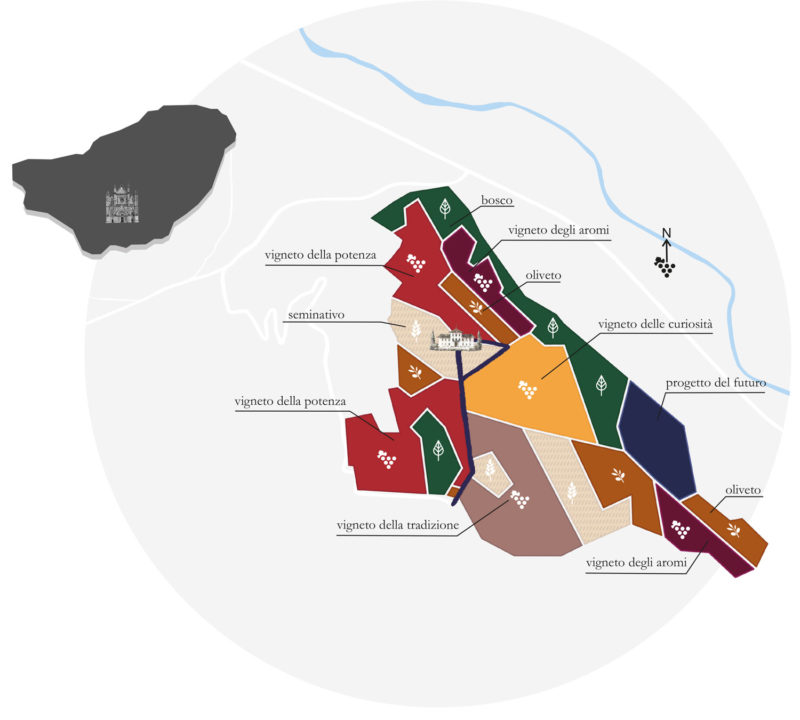The Farm
The Tenuta Le Velette farm is a single estate of about 270 hectares, in view of the city of Orvieto, at an elevation that varies from 270 to 330 meters above sea level.
This large area has allowed us to identify about 130 hectares ideal for vineyards, which, depending on their exposure, are used for the different varieties of vines that best benefit from each of these positions.
Althoughthey are long-lived, even grapevines age and must be removed. The planning of the soil regeneration periods, approximately every 30 years, as the vineyards grow older, leads us to growing annual crops for this purpose.
Even if they are intended for a future new vineyard, or are used to cultivate those areas whose positions do not make them usable otherwise, they help keep the farm diversified and give the landscape a natural balance that is clearly visible and perceptible, with vineyards being greatly preeminent.

The Farm
The Tenuta Le Velette farm is a single estate of about 270 hectares, in view of the city of Orvieto, at an elevation that varies from 270 to 330 meters above sea level.
This large area has allowed us to identify about 130 hectares ideal for vineyards, which, depending on their exposure, are used for the different varieties of vines that best benefit from each of these positions.
Althoughthey are long-lived, even grapevines age and must be removed. The planning of the soil regeneration periods, approximately every 30 years, as the vineyards grow older, leads us to growing annual crops for this purpose.
Even if they are intended for a future new vineyard, or are used to cultivate those areas whose positions do not make them usable otherwise, they help keep the farm diversified and give the landscape a natural balance that is clearly visible and perceptible, with vineyards being greatly preeminent.

The Farm
The Tenuta Le Velette farm is a single estate of about 270 hectares, in view of the city of Orvieto, at an elevation that varies from 270 to 330 meters above sea level.
This large area has allowed us to identify about 130 hectares ideal for vineyards, which, depending on their exposure, are used for the different varieties of vines that best benefit from each of these positions.
Althoughthey are long-lived, even grapevines age and must be removed. The planning of the soil regeneration periods, approximately every 30 years, as the vineyards grow older, leads us to growing annual crops for this purpose.
Even if they are intended for a future new vineyard, or are used to cultivate those areas whose positions do not make them usable otherwise, they help keep the farm diversified and give the landscape a natural balance that is clearly visible and perceptible, with vineyards being greatly preeminent.

Olive groves also contribute to this sensation. About 3000 trees, a great historical legacy for the area, produce a small amount of extra virgin olive oil, the high quality of which expresses our care for doing things well.
Woods, isolated centuries-old trees, farmhouses with ancient cellars dug out of volcanic tuff stone and being restored, ditches and roads maintained with their natural border of original spontaneous vegetation, all outline and divide, but also unite all that which makes up the farm.
Lately a small part of the farm has been set aside for a more experimental research or recovery project; the two concepts often coincide, of how to ensure for another thousand years the millennial history that we have behind us. After years of intense viticultural and enological research, the identifying of a way of experiencing the agricultural world has shown its fundamental value, and the 270 hectares of Tenuta Le Velette can be its own small, balanced and complete agricultural world. This is the task of our future generations, which is beginning today.
Olive groves also contribute to this sensation. About 3000 trees, a great historical legacy for the area, produce a small amount of extra virgin olive oil, the high quality of which expresses our care for doing things well.
Woods, isolated centuries-old trees, farmhouses with ancient cellars dug out of volcanic tuff stone and being restored, ditches and roads maintained with their natural border of original spontaneous vegetation, all outline and divide, but also unite all that which makes up the farm.
Lately a small part of the farm has been set aside for a more experimental research or recovery project; the two concepts often coincide, of how to ensure for another thousand years the millennial history that we have behind us. After years of intense viticultural and enological research, the identifying of a way of experiencing the agricultural world has shown its fundamental value, and the 270 hectares of Tenuta Le Velette can be its own small, balanced and complete agricultural world. This is the task of our future generations, which is beginning today.
Olive groves also contribute to this sensation. About 3000 trees, a great historical legacy for the area, produce a small amount of extra virgin olive oil, the high quality of which expresses our care for doing things well.
Woods, isolated centuries-old trees, farmhouses with ancient cellars dug out of volcanic tuff stone and being restored, ditches and roads maintained with their natural border of original spontaneous vegetation, all outline and divide, but also unite all that which makes up the farm.
Lately a small part of the farm has been set aside for a more experimental research or recovery project; the two concepts often coincide, of how to ensure for another thousand years the millennial history that we have behind us. After years of intense viticultural and enological research, the identifying of a way of experiencing the agricultural world has shown its fundamental value, and the 270 hectares of Tenuta Le Velette can be its own small, balanced and complete agricultural world. This is the task of our future generations, which is beginning today.

